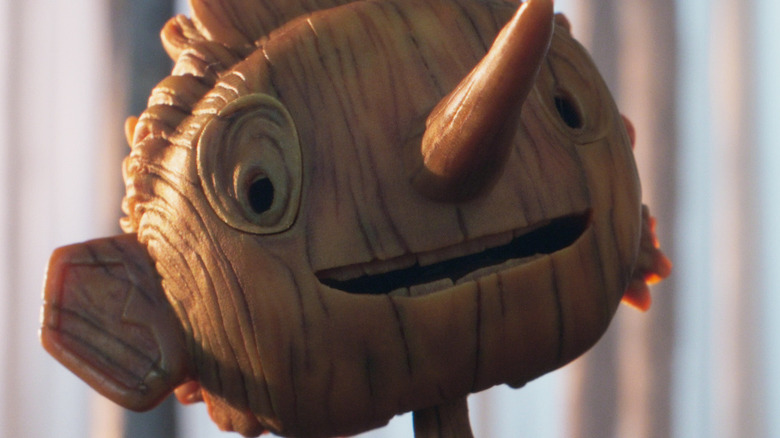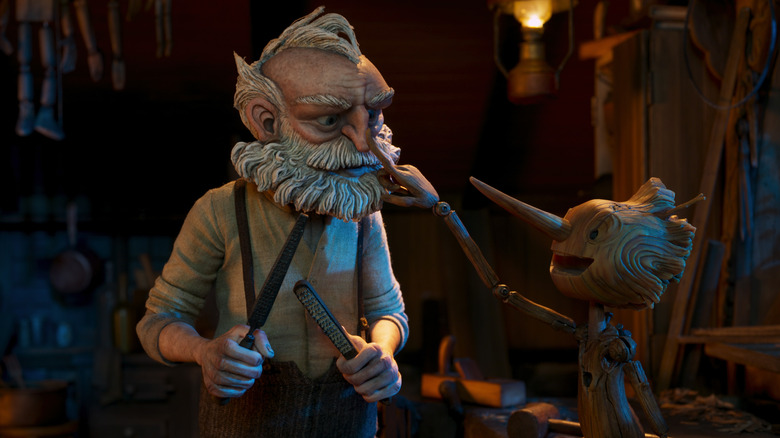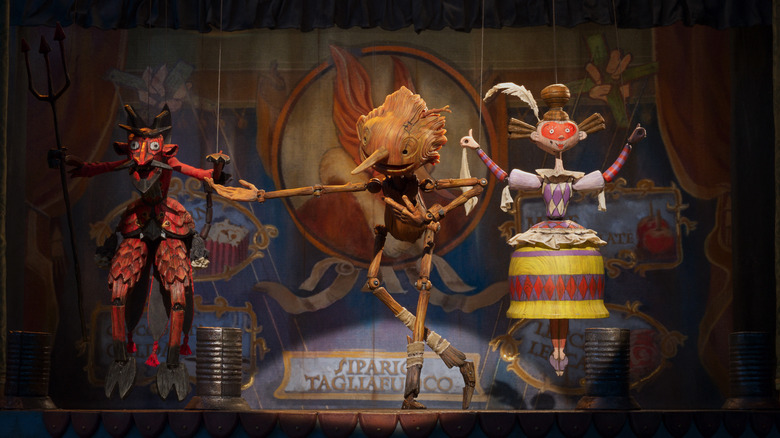Pinocchio Review: A Hand Crafted Work Of Art
- It's beautifully made
- The cast is terrific
- The method of filmmaking enhances the message
- It might be slightly too long in places
There's an element of destiny running through Guillermo del Toro's "Pinocchio," a years-in-the-making adaptation of Carlo Collodi's classic story which grew out of the filmmaker's lifelong love affair with stop-motion animation. Every del Toro film is special in its way, even the ones which don't quite work, because you can feel the director's passion, his attention to detail, and his enthusiasm for his craft. However, "Pinocchio" carries a particular air of tangible magic in its frames. From the beginning, it's like the little wooden boy and the man who loves monsters were made for each other.
That feeling is, of course, helped along by the inherent sense of commitment required to make something like a stop-motion film. It's a painstaking process, and when it's done well it can feel like magic, but doing it well is difficult and requires commitment, expertise, and a lot of time. In the case of "Pinocchio," that commitment feels like time well spent when you watch even a single scene, but this isn't simply a case of a passionate filmmaker and a crew willing to put in long hours to make something complex. The complexity is there, but what stands out about "Pinocchio," and what will continue to stand out on repeat viewings of this handmade display of brilliance, is the pure, deeply realized sense of emotion running through the entire movie. In rendering the classic story this way, with this cast and this crew, del Toro and his collaborators have given a timeless tale vibrant, jaw-dropping new life, and in the process delivered one of the best films of the year.
A little wooden boy
Everyone knows the story of "Pinocchio" — or at least the basic structure that provides a catalyst for the character's adventures out in the world. Geppetto (David Bradley) is a kindly carpenter whose life is lonelier after losing his young son, so he decides to carve a little wooden boy to lift his own spirits. Through a magical intervention, the wooden boy (Gregory Mann) comes to life as Pinocchio and heads out into the world under the guidance of a kindly cricket (Ewan McGregor) to seek his fortune, his father's approval, and eventually his own humanity.
That's still the essential scaffolding at work in Guillermo del Toro and co-writer Patrick McHale's script, but much more tumultuous color is brushed in along the way. Much of the arc of Pinocchio's journey is still the same, but this is far from the Disney version you grew up with.
Del Toro and McHale begin their journey amid the horrors of war, then explore the rise of fascism in Italy and the looming presence of Benito Mussolini as a malevolent figure of ever-expanding corruption in the beautiful Italian countryside. Mussolini's presence heightens the impact of the figures in Pinocchio's life — from malevolent monkeys to carnival barkers — who'd rather exploit him than relate to him as a living thing, infusing the narrative with an added depth. Geppetto's life as a toymaker who attempts to recreate his own son is also explored in greater depth, as is the nature of Pinocchio's very existence as an inanimate object given life by forces beyond his understanding. All of these elements work to add complexity to what is still, at its core, a straightforward story of coming of age and learning to understand the world around you, even when part of that understanding is that there are certain things you will never, try as you might, truly grasp. It's a powerful, captivating bedrock for a narrative, upon which del Toro builds a masterwork.
Handmade wonders
Even beyond the sense of commitment and love that's gone into the making of "Pinocchio," there's a wit and poetry that comes from Guillermo del Toro and co-director Mark Gustafson's decision to make the film in old-fashioned, beautifully detailed stop-motion. Del Toro's version of the story explores many things, from the nature of good and evil to how exactly stories function in society to the nature of grief as a transformative experience, but it's also at its core the story about an artificial thing coming to life. It's about Pinocchio himself learning that he's more than wood and nails and about the world around him coming to learn that same lesson.
Therefore, if the stop-motion works, and we receive the emotional content of the story at its essential level, we are learning the same lesson as the characters in the film, while the film runs before us. And the stop-motion truly, vividly works. Del Toro and Gustafson infuse every scene, every frame, with rich detail and expressiveness that's both jaw-dropping and immediately immersive, while the voice cast led by Gregory Mann, David Bradley, and Ewan McGregor give voice to each of these characters with vulnerable, thrilling power. Scenes of Pinocchio performing in a traveling puppet show are predictably dazzling, of course, but so too are the quieter moments, time spent beside an old tree or in the confines of Geppetto's workshop. Every moment feels like you could reach out and touch it, live in it, experience it. So when the film asks you to believe in the heart and soul of a little boy who wasn't born, but sculpted by human hands, you have no trouble following it down that path.
Guillermo del Toro has made a career out of asking us to believe in the reality inherent in his fantasies, in the humanity inherent in his monsters. With "Pinocchio," he has delivered perhaps the purest distillation yet of this message, a remarkable achievement that will fill you with warmth and light.
"Pinocchio" arrives on Netflix on Friday, December 9.


